ITC506: Ethical Dilemma Analysis of a Development Methodology Scenario
VerifiedAdded on 2021/04/21
|7
|2053
|44
Report
AI Summary
This report analyzes an ethical dilemma that arose in a development project, focusing on a scenario where a junior developer took a client call without the project manager's knowledge. The report utilizes the Doing Ethics Technique (DET) to dissect the situation, identifying facts, non-ethical and ethical issues, and stakeholders involved. It explores the implications of the junior developer's actions, including potential impacts on the project, the client, and team dynamics. The analysis presents and evaluates three potential options for the project manager, ultimately recommending the option that prioritizes communication, guidance, and ethical leadership. The report concludes by emphasizing the importance of clear communication protocols and ethical decision-making within development teams. The report adheres to APA style referencing, and demonstrates a clear understanding of the ethical considerations involved in project management and client relations within a business context.
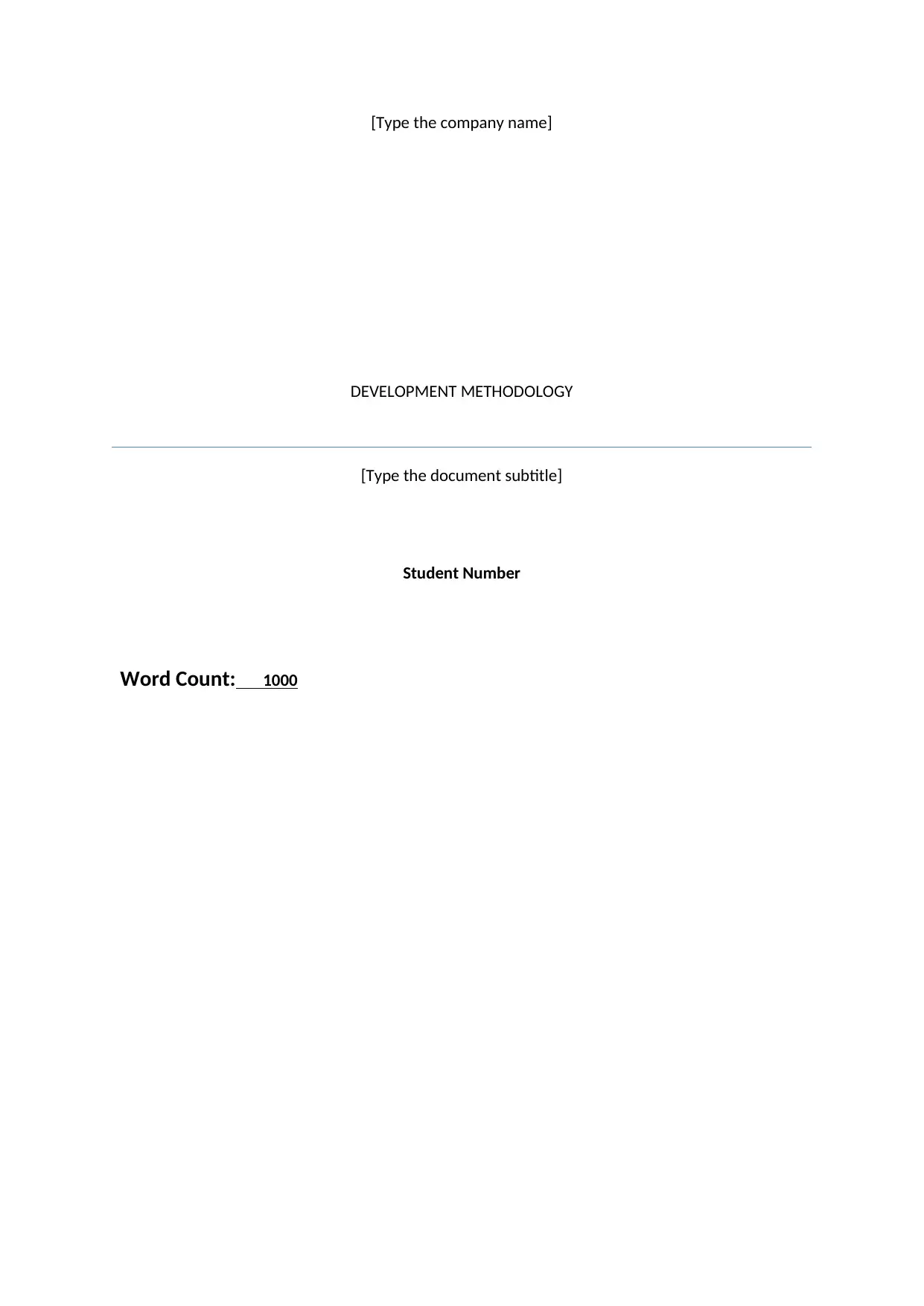
[Type the company name]
DEVELOPMENT METHODOLOGY
[Type the document subtitle]
Student Number
Word Count: 1000
DEVELOPMENT METHODOLOGY
[Type the document subtitle]
Student Number
Word Count: 1000
Paraphrase This Document
Need a fresh take? Get an instant paraphrase of this document with our AI Paraphraser
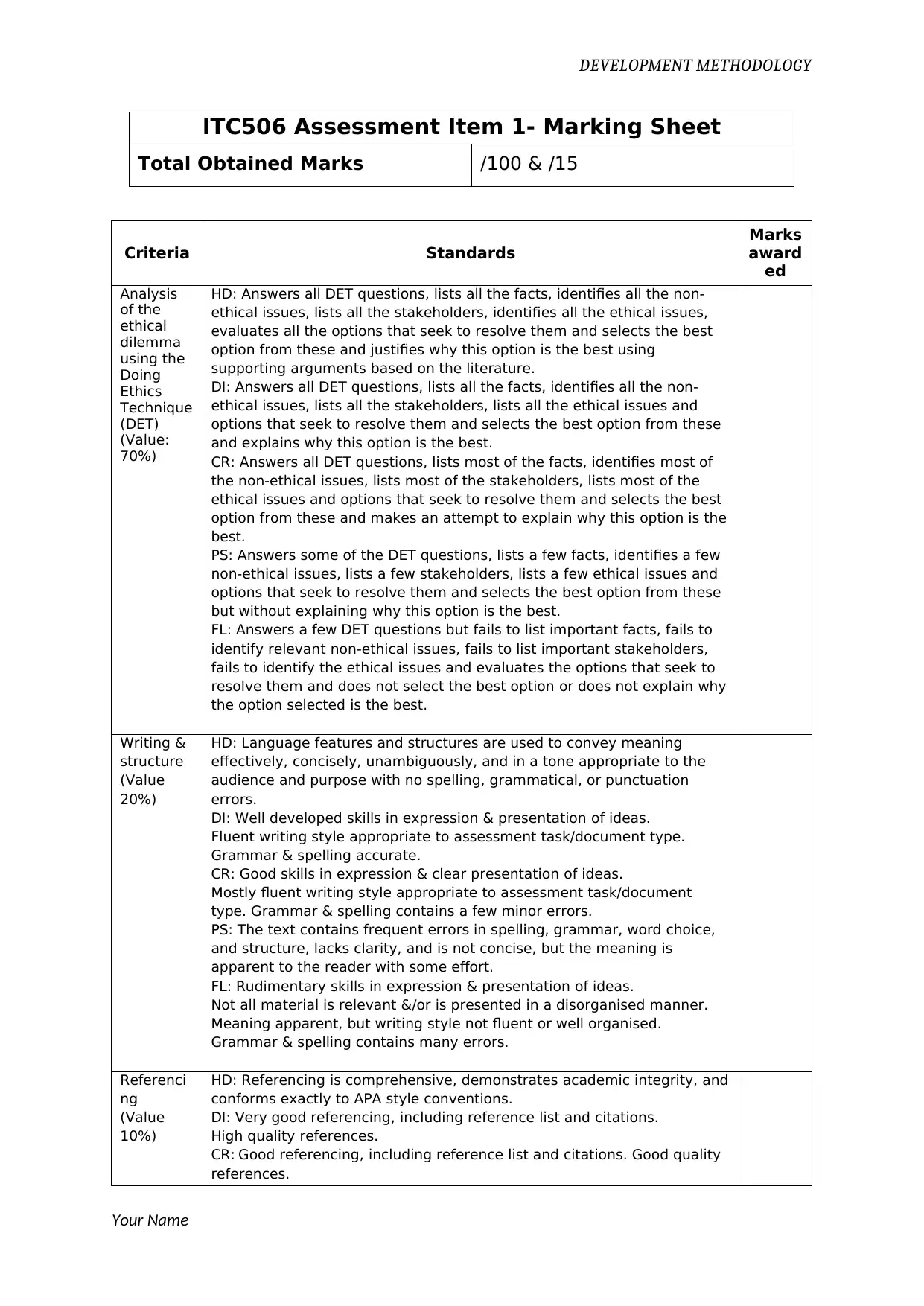
DEVELOPMENT METHODOLOGY
ITC506 Assessment Item 1- Marking Sheet
Total Obtained Marks /100 & /15
Criteria Standards
Marks
award
ed
Analysis
of the
ethical
dilemma
using the
Doing
Ethics
Technique
(DET)
(Value:
70%)
HD: Answers all DET questions, lists all the facts, identifies all the non-
ethical issues, lists all the stakeholders, identifies all the ethical issues,
evaluates all the options that seek to resolve them and selects the best
option from these and justifies why this option is the best using
supporting arguments based on the literature.
DI: Answers all DET questions, lists all the facts, identifies all the non-
ethical issues, lists all the stakeholders, lists all the ethical issues and
options that seek to resolve them and selects the best option from these
and explains why this option is the best.
CR: Answers all DET questions, lists most of the facts, identifies most of
the non-ethical issues, lists most of the stakeholders, lists most of the
ethical issues and options that seek to resolve them and selects the best
option from these and makes an attempt to explain why this option is the
best.
PS: Answers some of the DET questions, lists a few facts, identifies a few
non-ethical issues, lists a few stakeholders, lists a few ethical issues and
options that seek to resolve them and selects the best option from these
but without explaining why this option is the best.
FL: Answers a few DET questions but fails to list important facts, fails to
identify relevant non-ethical issues, fails to list important stakeholders,
fails to identify the ethical issues and evaluates the options that seek to
resolve them and does not select the best option or does not explain why
the option selected is the best.
Writing &
structure
(Value
20%)
HD: Language features and structures are used to convey meaning
effectively, concisely, unambiguously, and in a tone appropriate to the
audience and purpose with no spelling, grammatical, or punctuation
errors.
DI: Well developed skills in expression & presentation of ideas.
Fluent writing style appropriate to assessment task/document type.
Grammar & spelling accurate.
CR: Good skills in expression & clear presentation of ideas.
Mostly fluent writing style appropriate to assessment task/document
type. Grammar & spelling contains a few minor errors.
PS: The text contains frequent errors in spelling, grammar, word choice,
and structure, lacks clarity, and is not concise, but the meaning is
apparent to the reader with some effort.
FL: Rudimentary skills in expression & presentation of ideas.
Not all material is relevant &/or is presented in a disorganised manner.
Meaning apparent, but writing style not fluent or well organised.
Grammar & spelling contains many errors.
Referenci
ng
(Value
10%)
HD: Referencing is comprehensive, demonstrates academic integrity, and
conforms exactly to APA style conventions.
DI: Very good referencing, including reference list and citations.
High quality references.
CR: Good referencing, including reference list and citations. Good quality
references.
Your Name
ITC506 Assessment Item 1- Marking Sheet
Total Obtained Marks /100 & /15
Criteria Standards
Marks
award
ed
Analysis
of the
ethical
dilemma
using the
Doing
Ethics
Technique
(DET)
(Value:
70%)
HD: Answers all DET questions, lists all the facts, identifies all the non-
ethical issues, lists all the stakeholders, identifies all the ethical issues,
evaluates all the options that seek to resolve them and selects the best
option from these and justifies why this option is the best using
supporting arguments based on the literature.
DI: Answers all DET questions, lists all the facts, identifies all the non-
ethical issues, lists all the stakeholders, lists all the ethical issues and
options that seek to resolve them and selects the best option from these
and explains why this option is the best.
CR: Answers all DET questions, lists most of the facts, identifies most of
the non-ethical issues, lists most of the stakeholders, lists most of the
ethical issues and options that seek to resolve them and selects the best
option from these and makes an attempt to explain why this option is the
best.
PS: Answers some of the DET questions, lists a few facts, identifies a few
non-ethical issues, lists a few stakeholders, lists a few ethical issues and
options that seek to resolve them and selects the best option from these
but without explaining why this option is the best.
FL: Answers a few DET questions but fails to list important facts, fails to
identify relevant non-ethical issues, fails to list important stakeholders,
fails to identify the ethical issues and evaluates the options that seek to
resolve them and does not select the best option or does not explain why
the option selected is the best.
Writing &
structure
(Value
20%)
HD: Language features and structures are used to convey meaning
effectively, concisely, unambiguously, and in a tone appropriate to the
audience and purpose with no spelling, grammatical, or punctuation
errors.
DI: Well developed skills in expression & presentation of ideas.
Fluent writing style appropriate to assessment task/document type.
Grammar & spelling accurate.
CR: Good skills in expression & clear presentation of ideas.
Mostly fluent writing style appropriate to assessment task/document
type. Grammar & spelling contains a few minor errors.
PS: The text contains frequent errors in spelling, grammar, word choice,
and structure, lacks clarity, and is not concise, but the meaning is
apparent to the reader with some effort.
FL: Rudimentary skills in expression & presentation of ideas.
Not all material is relevant &/or is presented in a disorganised manner.
Meaning apparent, but writing style not fluent or well organised.
Grammar & spelling contains many errors.
Referenci
ng
(Value
10%)
HD: Referencing is comprehensive, demonstrates academic integrity, and
conforms exactly to APA style conventions.
DI: Very good referencing, including reference list and citations.
High quality references.
CR: Good referencing, including reference list and citations. Good quality
references.
Your Name
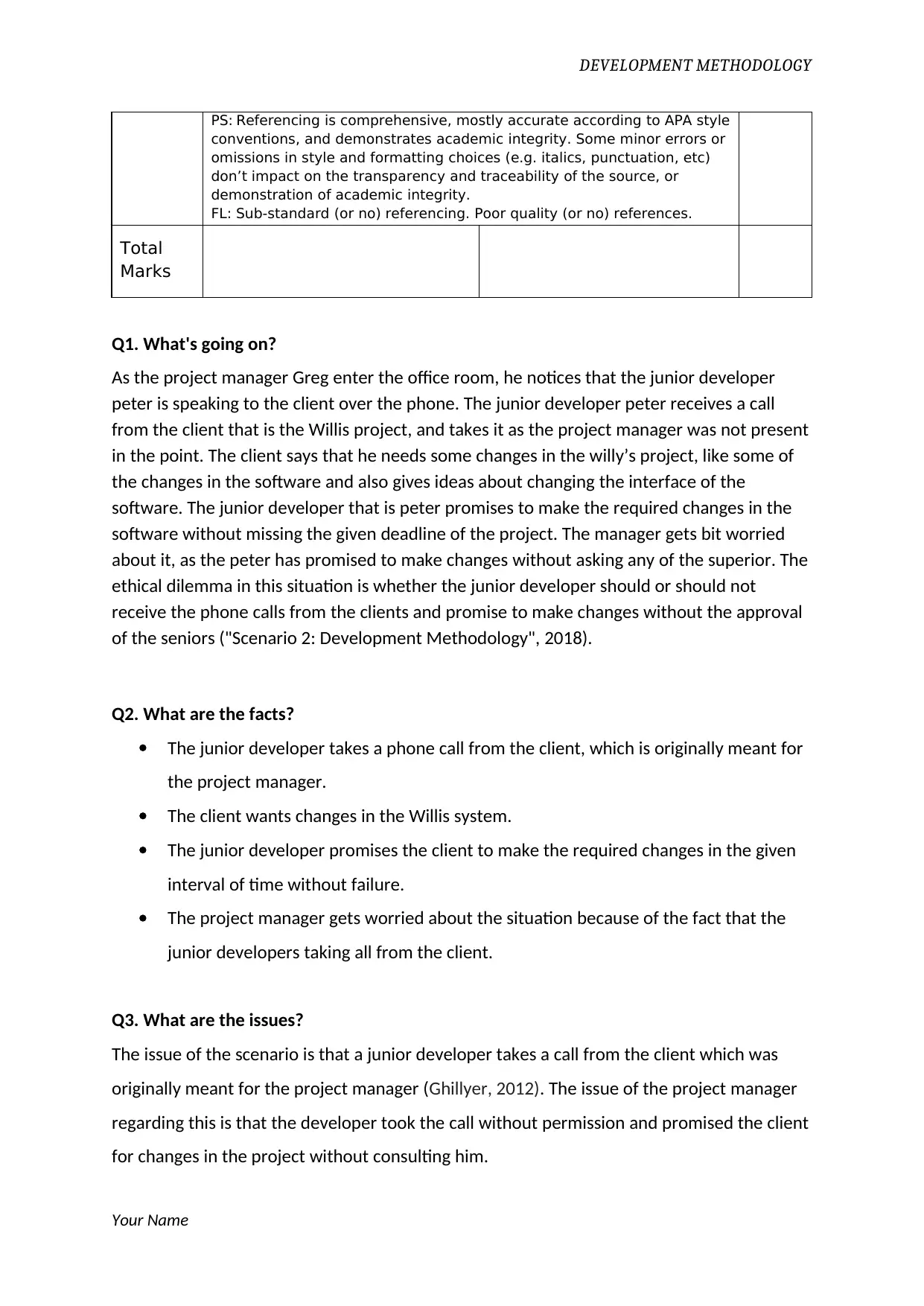
DEVELOPMENT METHODOLOGY
PS: Referencing is comprehensive, mostly accurate according to APA style
conventions, and demonstrates academic integrity. Some minor errors or
omissions in style and formatting choices (e.g. italics, punctuation, etc)
don’t impact on the transparency and traceability of the source, or
demonstration of academic integrity.
FL: Sub-standard (or no) referencing. Poor quality (or no) references.
Total
Marks
Q1. What's going on?
As the project manager Greg enter the office room, he notices that the junior developer
peter is speaking to the client over the phone. The junior developer peter receives a call
from the client that is the Willis project, and takes it as the project manager was not present
in the point. The client says that he needs some changes in the willy’s project, like some of
the changes in the software and also gives ideas about changing the interface of the
software. The junior developer that is peter promises to make the required changes in the
software without missing the given deadline of the project. The manager gets bit worried
about it, as the peter has promised to make changes without asking any of the superior. The
ethical dilemma in this situation is whether the junior developer should or should not
receive the phone calls from the clients and promise to make changes without the approval
of the seniors ("Scenario 2: Development Methodology", 2018).
Q2. What are the facts?
The junior developer takes a phone call from the client, which is originally meant for
the project manager.
The client wants changes in the Willis system.
The junior developer promises the client to make the required changes in the given
interval of time without failure.
The project manager gets worried about the situation because of the fact that the
junior developers taking all from the client.
Q3. What are the issues?
The issue of the scenario is that a junior developer takes a call from the client which was
originally meant for the project manager (Ghillyer, 2012). The issue of the project manager
regarding this is that the developer took the call without permission and promised the client
for changes in the project without consulting him.
Your Name
PS: Referencing is comprehensive, mostly accurate according to APA style
conventions, and demonstrates academic integrity. Some minor errors or
omissions in style and formatting choices (e.g. italics, punctuation, etc)
don’t impact on the transparency and traceability of the source, or
demonstration of academic integrity.
FL: Sub-standard (or no) referencing. Poor quality (or no) references.
Total
Marks
Q1. What's going on?
As the project manager Greg enter the office room, he notices that the junior developer
peter is speaking to the client over the phone. The junior developer peter receives a call
from the client that is the Willis project, and takes it as the project manager was not present
in the point. The client says that he needs some changes in the willy’s project, like some of
the changes in the software and also gives ideas about changing the interface of the
software. The junior developer that is peter promises to make the required changes in the
software without missing the given deadline of the project. The manager gets bit worried
about it, as the peter has promised to make changes without asking any of the superior. The
ethical dilemma in this situation is whether the junior developer should or should not
receive the phone calls from the clients and promise to make changes without the approval
of the seniors ("Scenario 2: Development Methodology", 2018).
Q2. What are the facts?
The junior developer takes a phone call from the client, which is originally meant for
the project manager.
The client wants changes in the Willis system.
The junior developer promises the client to make the required changes in the given
interval of time without failure.
The project manager gets worried about the situation because of the fact that the
junior developers taking all from the client.
Q3. What are the issues?
The issue of the scenario is that a junior developer takes a call from the client which was
originally meant for the project manager (Ghillyer, 2012). The issue of the project manager
regarding this is that the developer took the call without permission and promised the client
for changes in the project without consulting him.
Your Name
⊘ This is a preview!⊘
Do you want full access?
Subscribe today to unlock all pages.

Trusted by 1+ million students worldwide
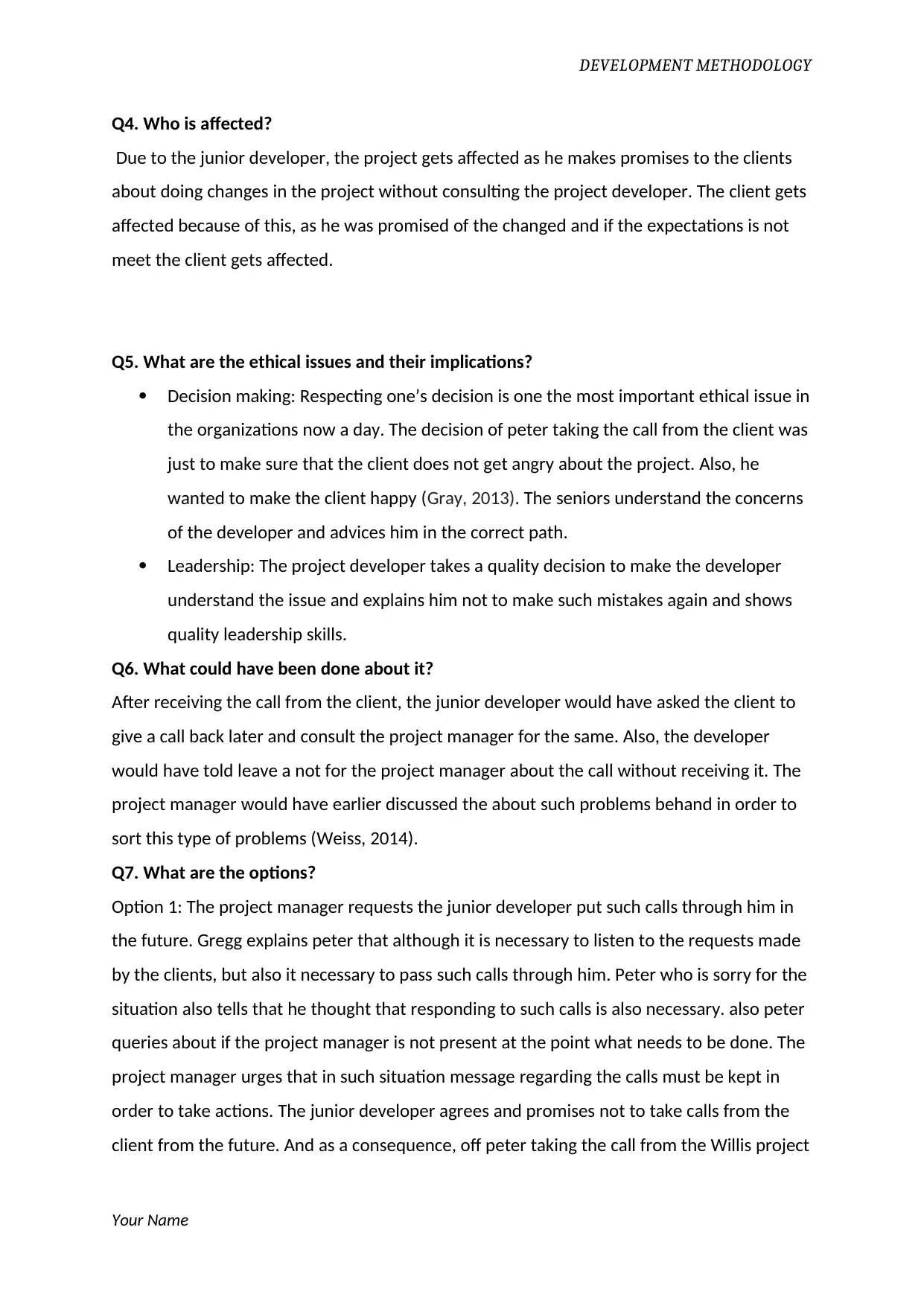
DEVELOPMENT METHODOLOGY
Q4. Who is affected?
Due to the junior developer, the project gets affected as he makes promises to the clients
about doing changes in the project without consulting the project developer. The client gets
affected because of this, as he was promised of the changed and if the expectations is not
meet the client gets affected.
Q5. What are the ethical issues and their implications?
Decision making: Respecting one’s decision is one the most important ethical issue in
the organizations now a day. The decision of peter taking the call from the client was
just to make sure that the client does not get angry about the project. Also, he
wanted to make the client happy (Gray, 2013). The seniors understand the concerns
of the developer and advices him in the correct path.
Leadership: The project developer takes a quality decision to make the developer
understand the issue and explains him not to make such mistakes again and shows
quality leadership skills.
Q6. What could have been done about it?
After receiving the call from the client, the junior developer would have asked the client to
give a call back later and consult the project manager for the same. Also, the developer
would have told leave a not for the project manager about the call without receiving it. The
project manager would have earlier discussed the about such problems behand in order to
sort this type of problems (Weiss, 2014).
Q7. What are the options?
Option 1: The project manager requests the junior developer put such calls through him in
the future. Gregg explains peter that although it is necessary to listen to the requests made
by the clients, but also it necessary to pass such calls through him. Peter who is sorry for the
situation also tells that he thought that responding to such calls is also necessary. also peter
queries about if the project manager is not present at the point what needs to be done. The
project manager urges that in such situation message regarding the calls must be kept in
order to take actions. The junior developer agrees and promises not to take calls from the
client from the future. And as a consequence, off peter taking the call from the Willis project
Your Name
Q4. Who is affected?
Due to the junior developer, the project gets affected as he makes promises to the clients
about doing changes in the project without consulting the project developer. The client gets
affected because of this, as he was promised of the changed and if the expectations is not
meet the client gets affected.
Q5. What are the ethical issues and their implications?
Decision making: Respecting one’s decision is one the most important ethical issue in
the organizations now a day. The decision of peter taking the call from the client was
just to make sure that the client does not get angry about the project. Also, he
wanted to make the client happy (Gray, 2013). The seniors understand the concerns
of the developer and advices him in the correct path.
Leadership: The project developer takes a quality decision to make the developer
understand the issue and explains him not to make such mistakes again and shows
quality leadership skills.
Q6. What could have been done about it?
After receiving the call from the client, the junior developer would have asked the client to
give a call back later and consult the project manager for the same. Also, the developer
would have told leave a not for the project manager about the call without receiving it. The
project manager would have earlier discussed the about such problems behand in order to
sort this type of problems (Weiss, 2014).
Q7. What are the options?
Option 1: The project manager requests the junior developer put such calls through him in
the future. Gregg explains peter that although it is necessary to listen to the requests made
by the clients, but also it necessary to pass such calls through him. Peter who is sorry for the
situation also tells that he thought that responding to such calls is also necessary. also peter
queries about if the project manager is not present at the point what needs to be done. The
project manager urges that in such situation message regarding the calls must be kept in
order to take actions. The junior developer agrees and promises not to take calls from the
client from the future. And as a consequence, off peter taking the call from the Willis project
Your Name
Paraphrase This Document
Need a fresh take? Get an instant paraphrase of this document with our AI Paraphraser
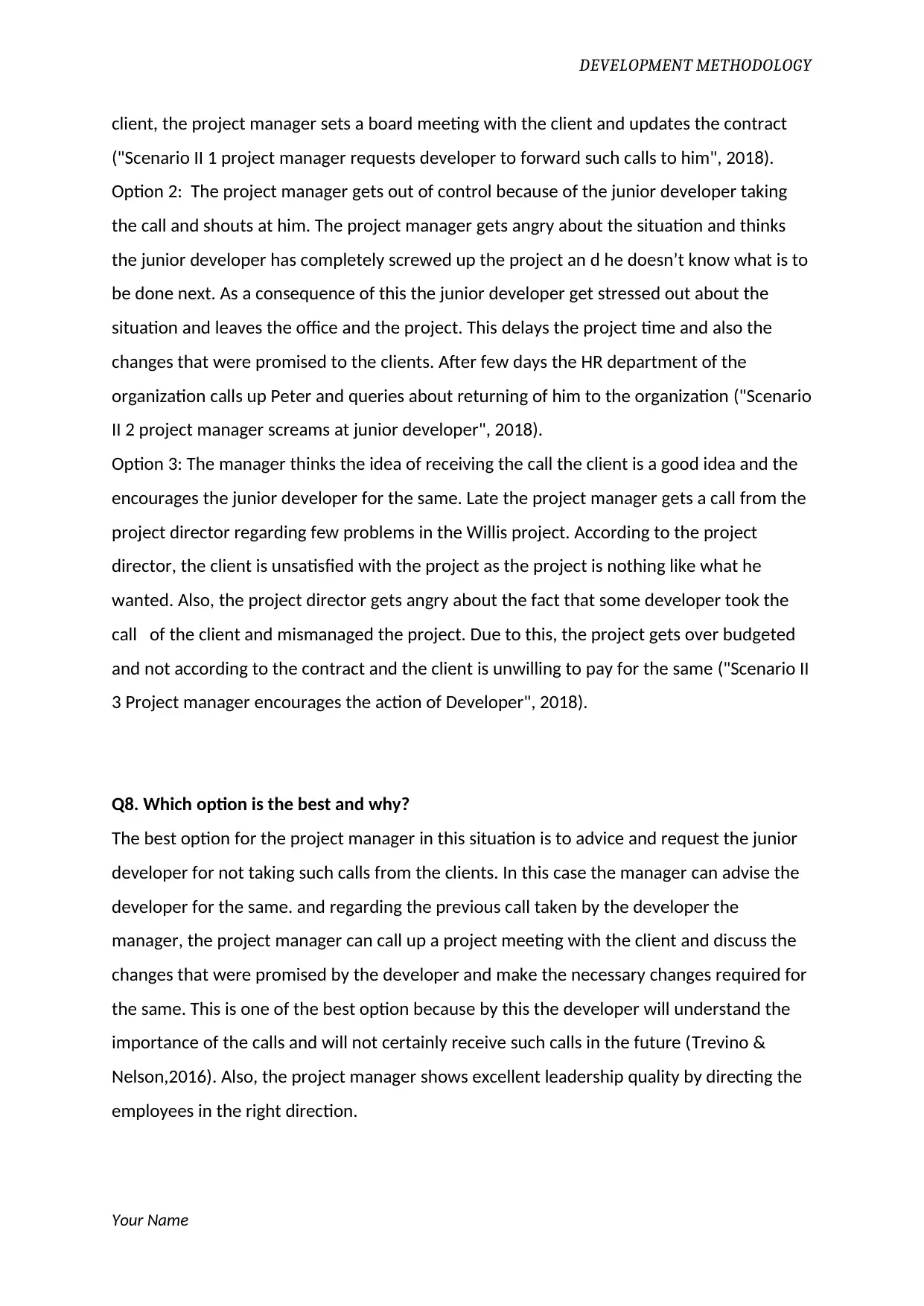
DEVELOPMENT METHODOLOGY
client, the project manager sets a board meeting with the client and updates the contract
("Scenario II 1 project manager requests developer to forward such calls to him", 2018).
Option 2: The project manager gets out of control because of the junior developer taking
the call and shouts at him. The project manager gets angry about the situation and thinks
the junior developer has completely screwed up the project an d he doesn’t know what is to
be done next. As a consequence of this the junior developer get stressed out about the
situation and leaves the office and the project. This delays the project time and also the
changes that were promised to the clients. After few days the HR department of the
organization calls up Peter and queries about returning of him to the organization ("Scenario
II 2 project manager screams at junior developer", 2018).
Option 3: The manager thinks the idea of receiving the call the client is a good idea and the
encourages the junior developer for the same. Late the project manager gets a call from the
project director regarding few problems in the Willis project. According to the project
director, the client is unsatisfied with the project as the project is nothing like what he
wanted. Also, the project director gets angry about the fact that some developer took the
call of the client and mismanaged the project. Due to this, the project gets over budgeted
and not according to the contract and the client is unwilling to pay for the same ("Scenario II
3 Project manager encourages the action of Developer", 2018).
Q8. Which option is the best and why?
The best option for the project manager in this situation is to advice and request the junior
developer for not taking such calls from the clients. In this case the manager can advise the
developer for the same. and regarding the previous call taken by the developer the
manager, the project manager can call up a project meeting with the client and discuss the
changes that were promised by the developer and make the necessary changes required for
the same. This is one of the best option because by this the developer will understand the
importance of the calls and will not certainly receive such calls in the future (Trevino &
Nelson,2016). Also, the project manager shows excellent leadership quality by directing the
employees in the right direction.
Your Name
client, the project manager sets a board meeting with the client and updates the contract
("Scenario II 1 project manager requests developer to forward such calls to him", 2018).
Option 2: The project manager gets out of control because of the junior developer taking
the call and shouts at him. The project manager gets angry about the situation and thinks
the junior developer has completely screwed up the project an d he doesn’t know what is to
be done next. As a consequence of this the junior developer get stressed out about the
situation and leaves the office and the project. This delays the project time and also the
changes that were promised to the clients. After few days the HR department of the
organization calls up Peter and queries about returning of him to the organization ("Scenario
II 2 project manager screams at junior developer", 2018).
Option 3: The manager thinks the idea of receiving the call the client is a good idea and the
encourages the junior developer for the same. Late the project manager gets a call from the
project director regarding few problems in the Willis project. According to the project
director, the client is unsatisfied with the project as the project is nothing like what he
wanted. Also, the project director gets angry about the fact that some developer took the
call of the client and mismanaged the project. Due to this, the project gets over budgeted
and not according to the contract and the client is unwilling to pay for the same ("Scenario II
3 Project manager encourages the action of Developer", 2018).
Q8. Which option is the best and why?
The best option for the project manager in this situation is to advice and request the junior
developer for not taking such calls from the clients. In this case the manager can advise the
developer for the same. and regarding the previous call taken by the developer the
manager, the project manager can call up a project meeting with the client and discuss the
changes that were promised by the developer and make the necessary changes required for
the same. This is one of the best option because by this the developer will understand the
importance of the calls and will not certainly receive such calls in the future (Trevino &
Nelson,2016). Also, the project manager shows excellent leadership quality by directing the
employees in the right direction.
Your Name

DEVELOPMENT METHODOLOGY
Your Name
Your Name
⊘ This is a preview!⊘
Do you want full access?
Subscribe today to unlock all pages.

Trusted by 1+ million students worldwide
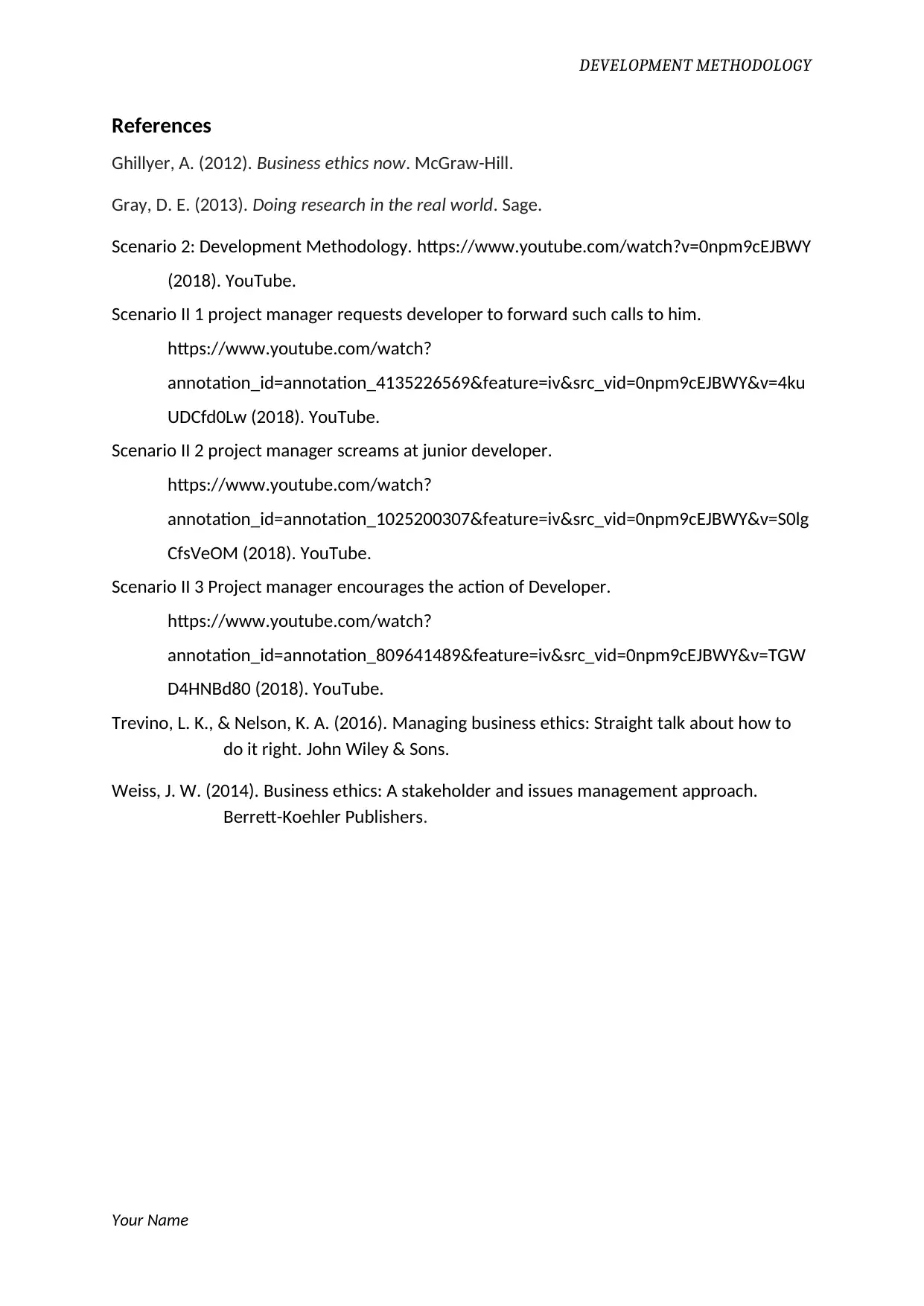
DEVELOPMENT METHODOLOGY
References
Ghillyer, A. (2012). Business ethics now. McGraw-Hill.
Gray, D. E. (2013). Doing research in the real world. Sage.
Scenario 2: Development Methodology. https://www.youtube.com/watch?v=0npm9cEJBWY
(2018). YouTube.
Scenario II 1 project manager requests developer to forward such calls to him.
https://www.youtube.com/watch?
annotation_id=annotation_4135226569&feature=iv&src_vid=0npm9cEJBWY&v=4ku
UDCfd0Lw (2018). YouTube.
Scenario II 2 project manager screams at junior developer.
https://www.youtube.com/watch?
annotation_id=annotation_1025200307&feature=iv&src_vid=0npm9cEJBWY&v=S0lg
CfsVeOM (2018). YouTube.
Scenario II 3 Project manager encourages the action of Developer.
https://www.youtube.com/watch?
annotation_id=annotation_809641489&feature=iv&src_vid=0npm9cEJBWY&v=TGW
D4HNBd80 (2018). YouTube.
Trevino, L. K., & Nelson, K. A. (2016). Managing business ethics: Straight talk about how to
do it right. John Wiley & Sons.
Weiss, J. W. (2014). Business ethics: A stakeholder and issues management approach.
Berrett-Koehler Publishers.
Your Name
References
Ghillyer, A. (2012). Business ethics now. McGraw-Hill.
Gray, D. E. (2013). Doing research in the real world. Sage.
Scenario 2: Development Methodology. https://www.youtube.com/watch?v=0npm9cEJBWY
(2018). YouTube.
Scenario II 1 project manager requests developer to forward such calls to him.
https://www.youtube.com/watch?
annotation_id=annotation_4135226569&feature=iv&src_vid=0npm9cEJBWY&v=4ku
UDCfd0Lw (2018). YouTube.
Scenario II 2 project manager screams at junior developer.
https://www.youtube.com/watch?
annotation_id=annotation_1025200307&feature=iv&src_vid=0npm9cEJBWY&v=S0lg
CfsVeOM (2018). YouTube.
Scenario II 3 Project manager encourages the action of Developer.
https://www.youtube.com/watch?
annotation_id=annotation_809641489&feature=iv&src_vid=0npm9cEJBWY&v=TGW
D4HNBd80 (2018). YouTube.
Trevino, L. K., & Nelson, K. A. (2016). Managing business ethics: Straight talk about how to
do it right. John Wiley & Sons.
Weiss, J. W. (2014). Business ethics: A stakeholder and issues management approach.
Berrett-Koehler Publishers.
Your Name
1 out of 7
Related Documents
Your All-in-One AI-Powered Toolkit for Academic Success.
+13062052269
info@desklib.com
Available 24*7 on WhatsApp / Email
![[object Object]](/_next/static/media/star-bottom.7253800d.svg)
Unlock your academic potential
Copyright © 2020–2025 A2Z Services. All Rights Reserved. Developed and managed by ZUCOL.





